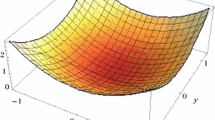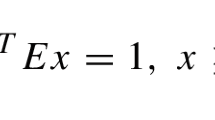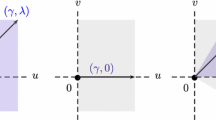Abstract
Primal or dual strong-duality (or min-sup, inf-max duality) in nonconvex optimization is revisited in view of recent literature on the subject, establishing, in particular, new characterizations for the second case. This gives rise to a new class of quasiconvex problems having zero duality gap or closedness of images of vector mappings associated to those problems. Such conditions are described for the classes of linear fractional functions and that of quadratic ones. In addition, some applications to nonconvex quadratic optimization problems under a single inequality or equality constraint, are presented, providing new results for the fulfillment of zero duality gap or dual strong-duality.
Similar content being viewed by others
References
Auslender, A.: Existence of optimal solutions and duality results under weak conditions. Math. Program. A 88, 45–59 (2000)
Auslender, A., Teboulle, M.: Asymptotic Cones and Functions in Optimization and Variational Inequalities. Springer, New York (2003)
Beck, A.: On the convexity of a class of quadratic mappings and its application to the problem of finding the smallest ball enclosing a given intersection of balls. J. Global Optim. 39, 113–126 (2007)
Borwein, J.M., Burachik, R., Yao, L.: Conditions for zero duality gap in convex programming. J. Convex Nonlinear Anal. 15, 167–190 (2014)
Bot, R.I.: Conjugate Duality in Convex Optimization. Springer, Berlin (2010)
Bot, R.I., Csetnek, E.R., Moldovan, A.: Revisiting some duality theorems via the quasirelative interior in convex optimization. J. Optim. Theory Appl. 139, 67–84 (2008)
Bot, R.I., Csetnek, E.R., Wanka, G.: Regularity conditions via quasi-relative interior in convex programming. SIAM J. Optim. 19, 217–233 (2008)
Bot, R.I., Grad, S.M., Wanka, G.: Fenchel’s duality theorem for nearly convex functions. J. Optim. Theory Appl. 132, 509–515 (2007)
Bot, R.I., Kassay, G., Wanka, G.: Duality for almost convex optimization problems via the perturbation approach. J. Global Optim. 42, 385–399 (2008)
Brecker, W.W., Kassay, G.: A systematization of convexity concepts for sets and functions. J. Convex Anal. 4, 109–127 (1997)
Burachik, R., Majeed, S.N.: Strong duality for generalized monotropic programming in infinite dimensions. J. Math. Anal. Appl. 400, 541–557 (2013)
Calabi, E.: Linear systems of real quadratic forms. Proc. Am. Math. Soc. 15, 844–846 (1964)
Cárcamo, G.; Flores-Bazán, F.: Strong duality and KKT conditions in nonconvex optimization with a single equality constraint and geometric constraint. Math. Program. B, Published on 15 October 2016. 10.1007/s10107-016-1078-3
Champion, T.: Duality gap in convex programming. Math. Program. A 99, 487–498 (2004)
Deng, S.: Coercivity properties and well posedness in vector optimization. RAIRO Oper. Res. 37, 195–208 (2003)
Dines, L.L.: On the mapping of quadratic forms. Bull. Am. Math. Soc. 47, 494–498 (1941)
Ernest, E., Volle, M.: Zero duality gap for convex programs: a generalization of the Clark–Duffin theorem. J. Optim. Theory Appl. 158, 668–686 (2013)
Ernest, E., Volle, M.: Zero duality gap and attainment with possibly non-convex data. J. Convex Anal. 23, 615–629 (2016)
Finsler, P.: Über das Vorkommen definiter und semi-definiter Formen in scharen quadratische Formen. Comment. Mat. Helv. 9, 188–192 (1937)
Flores-Bazán, F.: Existence theory for finite-dimensional pseudomonotone equilibrium problems. Acta Appl. Math. 77, 249–297 (2003)
Flores-Bazán, F., Flores-Bazán, F., Vera, C.: A complete characterization of strong duality in nonconvex optimization with a single constraint. J. Global Optim. 53, 185–201 (2012)
Flores-Bazán, F., Flores-Bazán, F., Vera, C.: Gordan-type alternative theorems and vector optimization revisited. In: Ansari, Q.H., Yao, J.C. (eds.) Recent Developments in Vector Optimization, pp. 29–59. Springer, Berlin (2012)
Flores-Bazán, F., Flores-Bazán, F., Vera, C.: Maximizing and minimizing quasiconvex functions: related properties, existence and optimality conditions via radial epiderivates. J. Global Optim. 63, 99–123 (2015)
Flores-Bazán, F., Hadjisavvas, N., Lara, F., Montenegro, I.: First and second order asymptotic analysis with applications in quasiconvex optimization. J. Optim. Theory Appl. 170, 372–393 (2016)
Flores-Bazán, F., Hadjisavvas, N., Vera, C.: An optimal alternative theorem and applications to mathematical programming. J. Global Optim. 37, 229–243 (2007)
Flores-Bazán, F., Jourani, A., Mastroeni, G.: On the convexity of the value function for a class of nonconvex variational problems: existence and optimality conditions. SIAM J. Control Optim. 52, 3673–3693 (2014)
Flores-Bazán, F., Mastroeni, G.: Strong duality in cone constrained nonconvex optimization. SIAM J. Optim. 23, 153–169 (2013)
Flores-Bazán, F., Mastroeni, G., Vera, C.: Proper or weak efficiency via saddle point conditions in cone constrained nonconvex vector optimization problems. Pre-print 2017-06, Departamento de Ingenieria Matematica, Universidad de Concepcion
Flores-Bazán, F., Opazo, F.: Characterizing the convexity of joint-range for a pair of inhomogeneous quadratic functions and strong duality. Minimax Theory Appl. 1, 257–290 (2016)
Flores-Bazán, F., Vera, C.: Unifying efficiency and weak efficiency in generalized quasiconvex vector minimization on the real-line. Int. J. Optim. Theory Methods Appl. 1, 247–265 (2009)
Frenk, J.B.G., Kassay, G.: On classes of generalized convex functions. Gordan–Farkas type theorems, and Lagrangian duality. J. Optim. Theory Appl. 102, 315–343 (1999)
Giannessi, F.: Constrained Optimization and Image Space Analysis. Springer, Berlin (2005)
Giannessi, F., Mastroeni, G.: Separation of sets and Wolfe duality. J. Global Optim. 42, 401–412 (2008)
Goberna, M.A., López, M.A., Volle, M.: Primal attainment in convex infinite optimization duality. J. Convex Anal. 21, 1043–1064 (2014)
Grad, A.: Quasi-relative interior-type constraint qualifications ensuring strong Lagrange duality for optimization problems with cone and affine constraints. J. Math. Anal. Appl. 361, 86–95 (2010)
Hadjisavvas, N., Komlósi, S., Schaible, S. (eds.): Handbook of Generalized Convexity and Generalized Monotonicity. Springer, Berlin (2005)
Jeyakumar, V.: Constraint qualifications characterizing Lagrangian duality in convex optimization. J. Optim. Theory Appl. 136, 31–41 (2008)
Jeyakumar, V., Lee, G.M.: Complete characterizations of stable Farkas lemma and cone-convex programming duality. Math. Program. A 114, 335–347 (2008)
Jeyakumar, V., Li, G.Y.: Stable zero duality gaps in convex programming: complete dual characterizations with applications to semidefinite programs. J. Math. Anal. Appl. 360, 156–167 (2009)
Jeyakumar, V., Oettli, W., Natividad, M.: A solvability theorem for a class of quasiconvex mappings with applications to optimization. J. Math. Anal. Appl. 179, 537–546 (1993)
Jeyakumar, V.: Wolkowicz: zero duality gaps in infinite-dimensional programming. J. Optim. Theory Appl. 67, 87–108 (1990)
Jeyakumar, V., Li, G.Y.: Trust-region problems with linear inequality constraints: exact SDP relaxation, global optimality and robust optimzation. Math. Program. A 147, 171–206 (2014)
Kuroiwa, D.: Convexity for set-valued maps. Appl. Math. Lett. 9, 97–101 (1996)
Mastroeni, G.: Some applications of the image space analysis to the duality theory for constrained extremum problems. J. Global Optim. 46, 603–614 (2010)
Polyak, B.T.: Convexity of quadratic transformations and its use in control and optimization. J. Optim. Theory Appl. 99, 553–583 (1998)
Rockafellar, R.T.: Convex Analysis. Princeton University Press, Princeton (1970)
Rockafellar, R.T.: Conjugate Duality and Optimization. SIAM, New Delhi (1974)
Tanaka, T.: General quasiconvexities, cones saddle points and minimax theorem for vector-valued functions. J. Optim. Theory Appl. 81, 355–377 (1994)
Tseng, P.: Some convex programs without a duality gap. Math. Program. B 116, 553–578 (2009)
Xia, Y., Wang, S., Sheu, R.L.: S-lemma with equality and its applications. Math. Program. A 156, 513–547 (2016)
Zǎlinescu, C.: Convex Analysis in General Vector Spaces. World Scientific, Singapore (2002)
Acknowledgements
The research for the first author was supported by the Programa Nacional de Innovación para la Competitividad y Productividad (Innóvate Perú), under contract 013-INNOVATEPERU-ECIP-2016, and was carried out partially while he was visiting IMCA-UNI during 2016. He is grateful for the hospitality of its members. The research material of this work was also supported in part by FONDECYT 115-0973 (Chile) and Basal project, CMM, Universidad de Chile, for the first author; whereas the fourth author was supported by FONDECYT 182-2015 (Perú), and part of his research was carried out while visited University of Concepcion. The authors want to express their gratitude to the referee for his/her careful reading of the manuscript and criticism, which were taken into account in the present version.
Author information
Authors and Affiliations
Corresponding author
Rights and permissions
About this article
Cite this article
Flores-Bazán, F., Echegaray, W., Flores-Bazán, F. et al. Primal or dual strong-duality in nonconvex optimization and a class of quasiconvex problems having zero duality gap. J Glob Optim 69, 823–845 (2017). https://doi.org/10.1007/s10898-017-0542-9
Received:
Accepted:
Published:
Issue Date:
DOI: https://doi.org/10.1007/s10898-017-0542-9
Keywords
- Zero duality gap
- Strong duality
- Linear fractional programming
- Quasiconvex programming
- Quadratic programming




